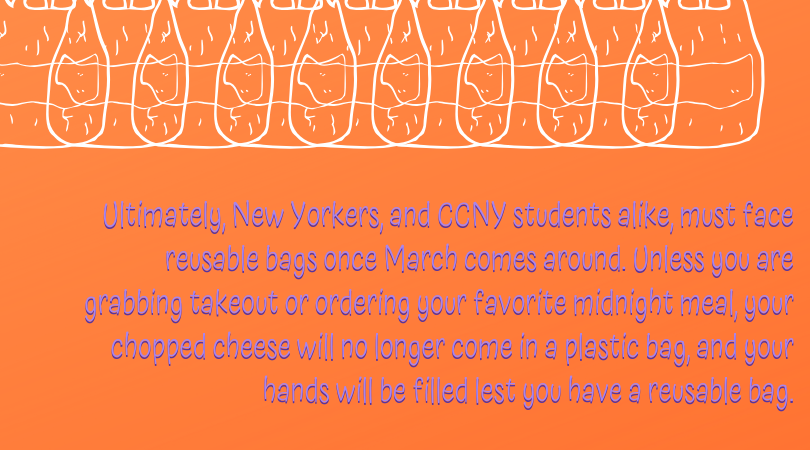Banishment of Plastic Bags in New York: What Will We Do Without Them?
Words by Gabriela Figueroa
Illustrations by Katie Herchenroeder
On Earth Day, April 22, Governor Andrew Cuomo signed a bill for a statewide ban of single-use plastic bags in New York, which will take effect in March 2020. In other words, plastic bags that your local bodega serves your food in, or the bags that help you carry your groceries home, will no longer be available for use. To compensate for this, some counties in New
York will offer a 5-cent fee for paper bags, but other than that, single-use plastic bags will be out of the picture. Bags used to wrap deli or meat counter products, newspaper, trash, recycling and restaurant-take out, will still be available for these purposes.
Back in March, Cuomo expressed his concern with them as they, “have blighted our environment and clogged our waterways.” Essentially, he wants to make sure that future generations of New Yorkers will be without these pollutants and spare them the difficulties of garbage in public areas.
Jason Wallace, executive director of the Auxiliary Enterprise Corporation for CCNY, refused to give a comment on how this will affect our campus. With Centerplate already gone, the Beaver Lodge has been implemented in its place - where you can still grab burgers, premade sandwiches, beverages, and some small snacks. Further, if you are not eating a meal, forks, spoons, knives - which all come in one small plastic pack - and plates will now cost you 25-cents. Plastic bags are still in use, but once they’re completely taken away, the CCNY community must learn to cope with their absence, especially within its cafeteria.
In fact, in this space, students may not even notice them gone, as tables are right off the registers, and will only need to hold their food for a few steps. Through all of this change, it is difficult to envision the future of the NAC Cafeteria and what might happen next year, but, ultimately, this is not the only source of food and beverage to keep in mind.

Surroundingcafes will have to quickly adapt to this new change. Susan Yang, co-owner ofCafé One located on the corner of W 140th Street and AmsterdamAvenue, a is excited to get rid of plastic and paper as well. As she describes,some customers quickly throw coffee trays, collars, and stoppers away as soonas they are put onto the cup. “I’d rather not use it but because customers likeit when they buy large items, or multiple items, we do provide it, but I thinkthat’s a great thing, I really am for the legislation… I think it makes senseto do that,” she said.
Café Onealone uses three to four boxes of plastic bags a week, with each box containingaround 500 bags, which students and other regulars usually throw out withinminutes of receiving it. In an attempt to reduce this waste, customers who stayto eat at the café are not given bags. However, having many customers, and beinga small business in a college setting, this might be a challenge to see plasticbags go, as they are essential with almost every order.
In order toprepare customers, Yang explained that she would definitely put up signs in thenear future, notifying them of the banishment. Ultimately, customers, andnearly anyone that eats at these local delis and cafes, will have to bringtheir own bags. Or, if not, they must take on the burden of carrying aroundtheir items by hand.
On thecontrary, some places have already started on the trend of no plastic. The SugarHill Café, located between St. Nicholas and Convent Avenue on W 145thStreet, tries to have as little asplastic as possible. They do not serve any of their items for takeout in aplastic bag, and serve their iced drinks with no lid unless the customer wantsone, which they have available on the side.

Thecounties who choose the 5-cent fee alternative will perpetuate some of thedownsides of plastic. To begin, these bags require more energy and greenhousegas emissions to produce. In 2011, Britain’s Environmental Agency tested the effects of both plasticand paper bags in the environmentthroughout each stage of the production process. What they realized is that theconsumer would have to use a paper bag three times in order to make up for one use of a polyethylene plastic bag.And while they can be recycled or composted much easier than plastic bags, thisstill does not make up for its harsh production process and life cycle.
RosaliaFernandez, a 61-year-old Spanish Harlem resident, absolutely cannot livewithout her plastic bags. “They’re always in my bag, and I use them whenever Ineed them when I shop for my stuff.” As she was walking around and making her compras, or daily groceries, she carriedtwo plastic bags in her own bag that she brought from home. “I’ll be sure tosave some before there’s no more!”
Ultimately, New Yorkers, and CCNY students alike, must face reusable bags once March comes around. Unless you are grabbing takeout or ordering your favorite midnight meal, your chopped cheese will no longer come in a plastic bag, and your hands will be filled lest you have a reusable bag.
One useful tip may be to have some of those totes at the entrance of your home to quickly grab before you leave the house. Some stores that already sell them: Trader Joes, Fairway, TJ Maxx, and Strand Bookstore - just to name a few. And once you get into the habit, plastic bags will be a thing of the past and future New Yorkers will thank you.




